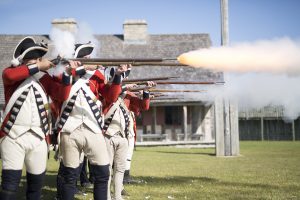
When you visit Colonial Michilimackinac, you’ll probably see a few historical interpreters representing British soldiers of the 8th Regiment going about their daily routine of demonstrations and tours. Every day, they fire their muskets for demonstration. Many people call these weapons a “Brown Bess,” but that name is overly generic and not necessarily appropriate for the 18th century. Let’s take a closer look at one of these muskets, properly referred to as the New Pattern Short Land Musket for Line Infantry.
Beginning in the 1720s, British soldiers were issued muskets manufactured to a standardized pattern. The Board of Ordnance contracted with individual gunsmiths to create various musket components such as locks, barrels, and brass furniture, which were assembled into completed weapons by Ordnance workers in the Tower of London or Dublin Castle. Contracts were let and weapons made up on an as-needed basis, and the economically-minded Board of Ordnance always tried to use up existing stores before using new ones, so there were always multiple versions of similar weapons in use at the same time. That being said, several distinctive musket patterns emerged over time, with unique variants for line infantry, mounted dragoons, artillerymen, noncommissioned officers, the militia, and sailors and marines. The Land series muskets were intended for infantry soldiers, with new patterns authorized in 1730, 1740, 1742, 1748, and 1756. Each model somehow improved upon its predecessors (such as the steel ramrod incorporated in the 1748 pattern), but these weapons all featured 46-inch-long barrels. There were experiments with shorter-barreled weapons, as in 1759 when Lt. Col. John LaFausille of the 8th Regiment supervised firing tests with muskets having half-length (23 inch) barrels in England. He reported that the short weapons had just as much penetrating power as the standard arms, and were less awkward for shorter men to handle. Despite his findings, British muskets remained long for the rest of the 18th century, in part because longer weapons, combined with a fixed bayonet to transform them into a pike, were more effective at repelling enemy cavalry.
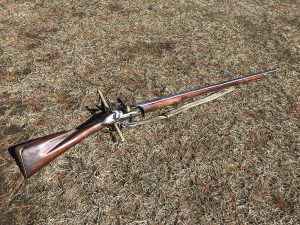
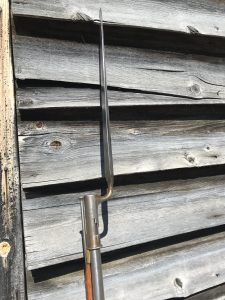
Although the Board of Ordnance never accepted such drastically shorted weapons, experience during the Seven Years’ War, and success with slightly smaller muskets issued to militiamen and aboard warships, convinced the Board of Ordnance to consider a new model weapon. After tests in early 1768, the board recommended a 42-inch barreled musket, which King George III formally approved in June. Contracts were let, and by the end of the year gunsmiths had delivered tens of thousands of components for the new muskets, which entered service in 1769. These weapons were officially known as New Pattern Short Land Musket for Line Infantry, or more concisely as the Pattern 1769 or Short Land musket.
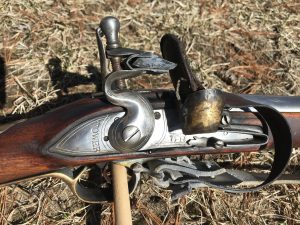
The musket featured here is a nice reproduction example of a Pattern 1769 Short Land musket. It has a 42 inch, .75 caliber smoothbore barrel. The lockplate, similar to those introduced on the Pattern 1756 Long Land muskets, is engraved with TOWER, indicating that the weapon originated in the Tower of London. Individual gunsmiths were previously allowed to engrave their own names on the plates, but the practice was abolished in 1764. The engraved crown, GR, and broad arrow in front of cock all indicate government ownership of the weapon. Individual units could further mark their weapons, usually by engraving on the barrel, and each weapon was assigned a rack and company number to link it to a specific soldier. These numbers were typically engraved on the wrist plate. The comb of the cock is relatively ornate, and the finial of the hammer spring has a delicate trefoil design. The next model musket, the Pattern 1777 Short Land, simplified many of these features but retained the same basic look of the Pattern 1769 weapons.
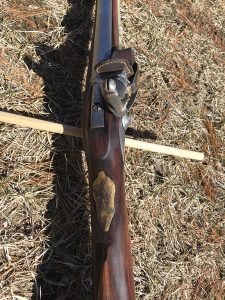
It is important to note that while interpreters at Michilimackinac today carry and demonstrate reproductions of the 1769 and 1777 Short Land weapons, historically the soldiers of the 8th Regiment probably carried the Pattern 1756 Long Land musket. As noted above, the government’s preference for exhausting existing weapons stores before issuing new models meant that the shorter 1769 muskets did not immediately replace the 1756 Long Lands. The 8th Regiment received its last large scale-issue of new arms in 1766, when the 1756 musket remained the standard. The 8th did receive some new weapons in 1771, 1775, and 1778. However, the first two issues were to replace older muskets worn out in service, while the 1778 issue covered the “augmentation” of the regiment caused by raising additional recruiting companies in England. As such, although Pattern 1769 Short Lands may have made an appearance in the hands of some soldiers of the 8th by the mid-1770s, it seems highly likely that the majority of men continued to carry the 1756 Long Lands, perhaps until they returned home to England in 1785. Indeed, the Pattern 1756 Long Land remained the standard issue weapon for grenadier companies (including the grenadiers of the 8th, posted at Michilimackinac) and guards regiments until the late 1780s, and the older weapon was never fully replaced by the Short Land weapons.
In any case, the weapons carried and fired by our interpreters today make up an important part of the daily programming at Colonial Michilimackinac. Be sure to ask the interpreters about their muskets when you visit. For tickets and more information please visit our website, and be sure to check out Mackinac Associates, which makes programs and exhibits possible throughout Mackinac State Historic Parks’ sites.









